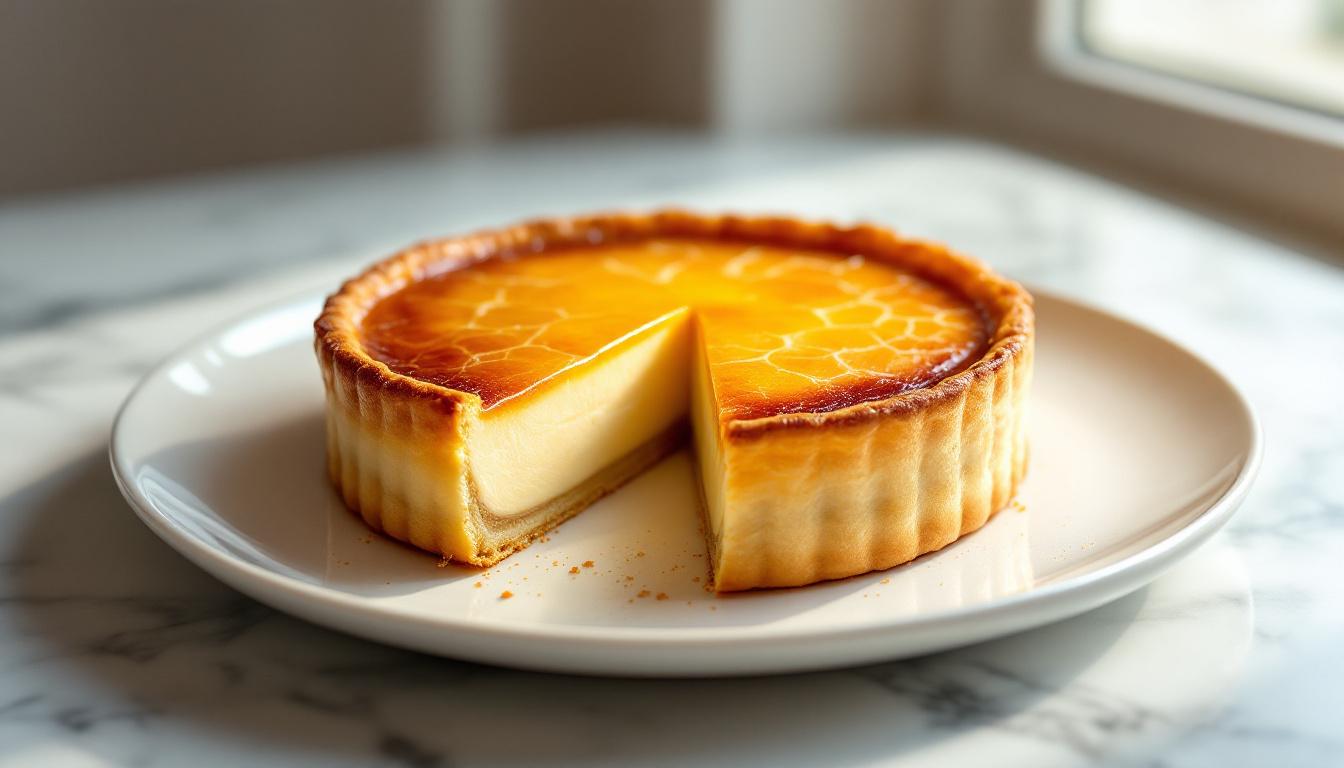During my years cooking in Provence, I discovered the transcendent pleasure of the Tartelette Chiboust – those perfect individual tarts with their crisp shells cradling a cloud-like cream that’s simultaneously rich yet ethereal. What makes this French classic so magical is the contrast between the delicate pastry, billowy cream, and that irresistible crackling caramel top that shatters under your spoon. The first time I served these at a dinner party, the conversation stopped mid-sentence as everyone experienced that perfect bite – the ultimate chef’s victory.
The Story
Crème Chiboust has fascinating origins, named after the 19th-century Parisian pâtissier who created this genius technique of folding Italian meringue into pastry cream. While you might know its cousin the lemon meringue tart, this preparation offers something uniquely sophisticated: a silky, stable cream that’s substantial enough to slice yet feels like biting into a sweet cloud. It’s the perfect marriage of richness and lightness.
Ingredients Spotlight
For the pâte sablée (makes 8 tartelettes):
- 1¼ cups (160g) all-purpose flour
- ½ cup (60g) confectioners’ sugar
- ¼ teaspoon fine sea salt
- 7 tablespoons (100g) cold unsalted butter, cubed
- 1 large egg yolk
- 1-2 tablespoons ice water (if needed)
For the crème chiboust:
- 1 cup (240ml) whole milk
- 1 vanilla bean, split lengthwise
- 4 large egg yolks
- ⅓ cup (65g) granulated sugar
- 3 tablespoons (24g) cornstarch
- 2 tablespoons (30g) unsalted butter
- 2 teaspoons (7g) powdered gelatin
- 2 tablespoons cold water
For the Italian meringue:
- 3 large egg whites, room temperature
- Pinch cream of tartar
- ⅔ cup (130g) granulated sugar
- 3 tablespoons (45ml) water
For the caramelized top:
- ¼ cup (50g) granulated sugar
Step-by-Step Guide
1. Prepare the tart shells: Pulse flour, sugar, and salt in a food processor. Add butter and pulse until pea-sized crumbs form. Add egg yolk and pulse until dough begins to come together. If too dry, add ice water by the teaspoon. Form into a disk, wrap, and refrigerate 1 hour.
2. Blind bake the shells: Roll dough to ⅛-inch thickness and cut circles to fit 3-inch tart molds. Press dough into molds, trim excess, prick bottoms with fork. Freeze 15 minutes. Line with parchment, fill with weights, and bake at 325°F (165°C) for 15 minutes. Remove weights and bake 5-7 minutes more until golden. Cool completely.
3. Make pastry cream: Heat milk with vanilla bean seeds and pod until steaming. Meanwhile, whisk egg yolks, sugar, and cornstarch until pale. Temper yolks by slowly adding hot milk while whisking. Return mixture to saucepan and cook over medium heat, whisking constantly, until thickened and bubbling (about 2 minutes). Remove from heat, stir in butter.
4. Add gelatin: Bloom gelatin in cold water for 5 minutes. Melt in microwave for 10 seconds and stir into hot pastry cream. Transfer to a bowl, press plastic wrap directly onto surface, and cool to room temperature (about 30 minutes).
5. Prepare Italian meringue: Begin whipping egg whites with cream of tartar on medium speed. Meanwhile, combine sugar and water in a small saucepan and heat to 240°F (115°C). With mixer running, slowly pour hot syrup into whites in a thin stream. Increase to high speed and whip until glossy peaks form and mixture cools (about 5 minutes).
6. Create crème chiboust: Whisk cooled pastry cream until smooth. Fold in one-third of meringue to lighten, then gently fold in remaining meringue until no streaks remain.
7. Assemble and finish: Pipe or spoon chiboust cream into cooled tart shells, creating a slight dome. Refrigerate until set, about 2 hours. Just before serving, sprinkle each tart with a thin, even layer of sugar and caramelize with a kitchen torch until bubbling and amber.
Expert Techniques
The key to extraordinary chiboust lies in proper temperature control. Your pastry cream must cool enough not to deflate the meringue, but remain warm enough to dissolve gelatin completely. I learned from a French master that if you whisk the pastry cream vigorously every 5 minutes as it cools, you’ll get a silkier final texture that rivals any Parisian pâtisserie.
Chef’s Note: For the most dramatic caramelized top, chill the filled tarts thoroughly before torching. This creates maximum contrast between the cool, silky cream and the warm, crackling caramel—the same principle that makes perfect chocolate mousse so compelling.
When making Italian meringue, I target what we call the “softball stage” (240°F/115°C) for the sugar syrup. This precise temperature ensures your meringue will be stable enough to fold into the pastry cream without deflating, yet still maintain that ethereal texture that defines a true chiboust.
Presentation & Pairing Ideas
Serve these elegant tartelettes on small dessert plates with a light dusting of powdered sugar around the edges. During berry season, I add a few fresh raspberries or a swirl of tart fruit coulis alongside to cut through the richness. For an impressive dinner party finale, arrange the tartelettes on a mirror or dark slate for dramatic effect.
Wine pairing is crucial here—opt for a Sauternes whose honeyed notes echo the caramelized top, or for something lighter, a Moscato d’Asti brings refreshing effervescence. If you’ve added berries, a late-harvest Gewürztraminer creates magic with its complementary fruit notes.
These tartelettes welcome seasonal adaptations: fold in lemon zest during spring, a touch of lavender in summer, or a hint of spice during fall. The cream base provides a perfect canvas for expressing the moment’s flavors, much like the way a good focaccia adapts to seasonal herbs.
Remember, the beauty of these tartelettes isn’t just in their precise execution, but in how they become yours. Whether you layer in citrus notes or add a touch of unexpected spice, cooking is about discovery. Create something that makes your guests ask not just for the recipe, but for your secret. That’s when you know you’ve truly mastered the dish. 🍮✨
